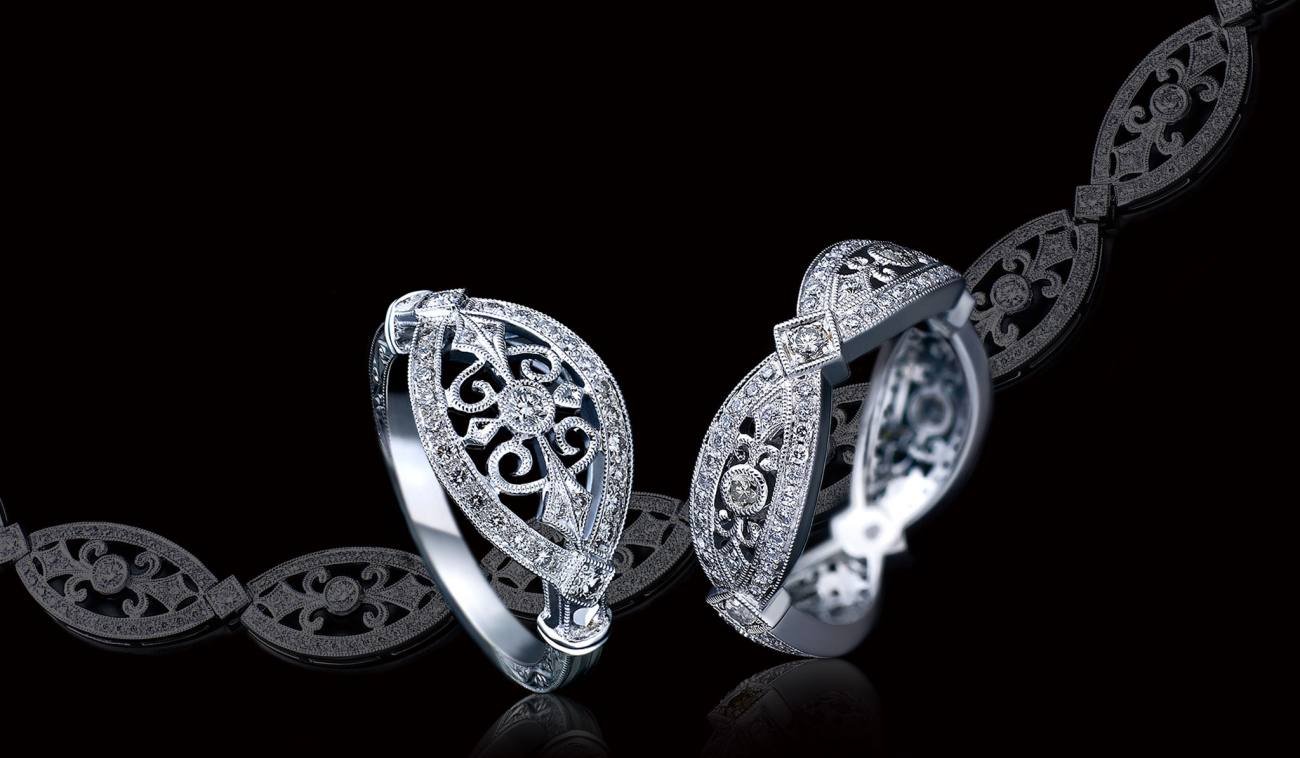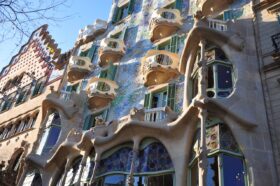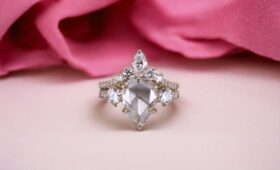
24 Jan A Brief History of Renaissance Architecture & Jewelry Design
Scrollwork, as seen in the above Carl Blackburn custom jewelry, is often found in Renaissance era architecture.
Renaissance architecture, which emerged in the 15th and 16th centuries, has had a lasting influence on jewelry design, blending elegance with symmetry, proportion, and intricate details. Inspired by classical Greek and Roman art, Renaissance architects embraced harmonious forms, geometric precision, and ornate decoration, all of which translated beautifully into jewelry craftsmanship. Jewelry from this era often mimicked architectural motifs such as arches, columns, and domes, reflecting the grandeur and sophistication of Renaissance buildings.
As a former student of the prestigious Accademia Italiana and a long-time admirer of the Renaissance masters, Carl Blackburn is a San Diego jewelry designer with an interest in all Renaissance art forms, especially architecture, which is seen at times in the custom jewelry that he creates from his boutique jewelry store in La Jolla, CA.
For instance, Carl’s filigree work in jewelry sometimes mirrors the intricate ornamentation of cathedral facades, while symmetrical arrangements of gemstones evoke the balanced layouts of Renaissance piazzas. Floral and scrollwork patterns, often seen in Renaissance carvings and frescoes, are a popular motif seen in many Carl Blackburn rings, earrings, and pendants over the past 25 years.
By incorporating these timeless designs, Carl pays homage to the Renaissance’s artistic achievements, blending history and luxury into wearable art. If you would like to discuss with Carl the making of Renaissance inspired jewelry, give him a call at 858-251-3006 or send him a text message at 619-723-8589.

What was the Renaissance?
The word “Renaissance” is derived from a French word meaning “re-birth,” and refers generally to the period between the early 15th and early 17th centuries. This time period is characterized by a great resurgence in learning and all the Arts.
Beginning in Italy and spreading throughout Europe, Renaissance cultural ideals can be traced to classical antiquity. And nowhere were these ideals more pronounced than in Renaissance architecture.
In general, Renaissance architects rejected the intricacy and verticality of Gothic style. Instead, they employed the simplicity and balanced proportionality of Roman and Greek architecture.
Classical Influence on Renaissance Architecture
Architects of the early Renaissance looked to ancient Greece and Rome for inspiration. Roman architecture was studied closely, and many young architects included a pilgrimage to Rome to study the ruins of the Colosseum and Pantheon as part of their education.
In addition to studying the actual structures, early Renaissance architects also embraced classical humanism, and helped raise the status of their craft from skilled labor to artist. Like the visual arts, architecture aimed to appeal to both reason and emotion.

Vitruvious and Renaissance Architecture
The Roman author and architect Vitruvious wrote his multi-volume masterwork, De Architectura, around 15 BC. This catalogue of engineering and architectural technique profoundly influenced the architects of the Renaissance when it was fortuitously re-discovered in 1414.
Vitruvious believed that architecture was an imitation of nature, and stated that buildings must exhibit three qualities: they must be solid, useful, and beautiful. He also believed that the sense of proportion exhibited in architecture should model itself on the greatest work of art: the human body.
Vitruvious defined these proportions in his Vitruvian Man, an image later drawn by the great Leonardo da Vinci. This drawing of the human body inscribed within a circle and square neatly encapsulates the perfection of human proportions, and is now one of the most recognizable images in the world.
Classical Orders in Renaissance Architecture
The classical orders are a kind of architectural ‘grammar’ that was first developed by the Greeks and later added to by the Romans.
The Greeks invented three architectural orders (Doric, Ionic, and Corinthian) to which the Romans added Tuscan and Composite. These orders are distinguished by proportions, characteristic details, and are most easily identified by the type of column used.
Differences in the base of the column, the capital (decorative top of the column), and entablatures (the moldings and bands above the column) define the orders, and Renaissance architects used all of this ‘grammar’ to write their own stories in their craft, beginning in Florence, Italy.
The Center of Renaissance Architecture
Florence is widely considered the cradle of the Renaissance, and this is true for Renaissance architecture as well. Florence’s unique combination of political stability, prosperity, and patronage fostered prolific investment in the arts, and in structures that allowed architects to employ their newly found scholarly approach to building design.
Another reason Florence led the change to Renaissance design ideals was that Italy had never fully embraced the Gothic style. The presence throughout Italy of architectural ruins illustrating an ordered, classical style had continued to inspire artists throughout the middle ages, and served as a model for Renaissance architects.

As Renaissance architects began to embrace the styles of classical antiquity, many aspects of design changed. Plans for Renaissance buildings became more square and symmetrical, and employed proportions based on a modular unit of measure. In a church, for instance, the unit might be the width of an aisle, and all the other proportions of the structure would be based on that module.
Building facades were usually symmetrical from side to side, and featured Roman orders of columns, windows, and pilasters that progressed toward the center. Multi-storied buildings often included regular repetitions of openings on each floor, and a centrally placed door highlighted by a balcony or rusticated (textured) surround.
Arches were used prominently, and were generally semi-circular. Above doors and windows, arches could be supported by piers or columns, often with a section of entablature between the column and the arch.
Decorative details in moldings and courses mimicked the ancient Romans, and were an important aspect of Renaissance architectural theory. The different orders had their own details, and they were replicated precisely throughout the period.
Domes were used frequently in Renaissance architecture, both structurally and aesthetically, first in churches, and later in secular architecture.
Spread of Renaissance Architecture through Europe
Renaissance architectural techniques and styles spread throughout Europe, in large measure because of the invention of the printing press. Not only was the recently discovered work of Vitruvious published and disseminated, so were a large number of popular and influential treatises.
Architectural treatises such as Alberti’s Ten Books on Architecture, Vignola’s The Rule of the Five Orders of Architecture, and Serlio’s Seven Books of Architecture were widely read, and helped spread the new revival of classic orders.

Major Figures in Renaissance Architecture
Filipo Brunelleschi is generally thought to be the first true Renaissance architect, and is credited with bringing the classical orders and linear perspective to architecture. His perception of the underlying mathematical order of Roman architecture informed all of his work.
Brunelleschi designs featured symmetry and careful consideration of proportion, in which all the architectural features have direct relationship to each other. His major works include the brick dome of Florence’s cathedral, and the churches of San Lorenzo and Santo Spirito in Florence.
Donato Bramante is considered the most representative architect of the High Renaissance. His use of the forms of classical antiquity in contemporary buildings exemplified the confidence Renaissance architects had in their use of the old forms. His church of San Pietro in Montorio was inspired by circular Roman temples, and his plan for St. Peter’s Basilica was the basis for the design completed by Michelangelo.
Michelangelo was the best known architect associated with the Late Renaissance, or Mannerist period. During this time there was a general relaxation of the severe simplicity and order of the High Renaissance.
In sculpture and painting, Mannerism was characterized by strangely elongated human models placed in complex, unnatural positions. In architecture, classical forms were often skewed, and classical balance and harmony sometimes distorted.
Lastly, Michelangelo is credited with creating the “giant order,” a large, elongated pilaster that stretched from the bottom to the top of a façade.

Renaissance Inspired Custom Jewelry
Carl Blackburn welcomes the opportunity to talk with you about the creation of Renaissance inspired jewelry, such as an engagement ring, eternity band, religious pendant, or iconic cufflinks. Schedule an informal chat with Carl at his La Jolla jewelry store today. Leave him a voicemail at 858-251-3006 or send him a text message at 619-723-8589. You may also send an email by using the contact form below.




